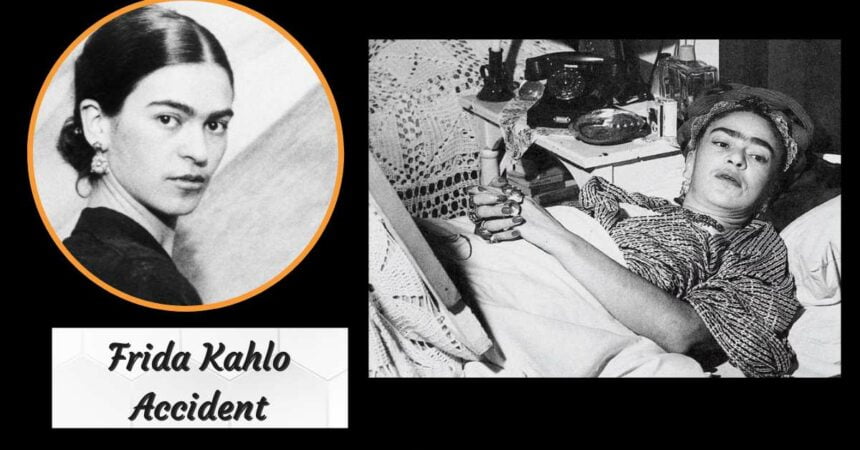Frida Kahlo’s paintings considered complex social and political themes, including sexism, classism, and feminism. Her writing, on the other hand, was reflective and filled with specifics from her own life. There was a bus accident when she was 18 years old that altered the course of her life forever. However, the details of Frida Kahlo’s bus crash remain a mystery.
The bus that Frida Kahlo travelled in crashed into an electric streetcar as it tried to pass it. Kahlo’s injuries were extensive and life-threatening after she was impaled on a railing, which caused it to pierce her belly. She suffered fractures to her spine, right leg, collarbone, shoulder, and three vertebrae.
Kahlo’s survival after the crash was miraculous given the number of casualties. However, the artist was not spared any harm, and the aftermath of the incident was far-reaching and indelible. What follows is a detailed account of the bus accident and its impact on Frida Kahlo’s life and art.
Frida Kahlo Accident
Frida Kahlo was just 18 years old and a student at Mexico’s National Preparatory School when the fateful bus accident occurred. On the dreary day of September 17, 1925, Frida had every intention of taking the bus home from school with her lover at the time, Alejandro Gómez Arias.
When they got on the bus, though, Kahlo realized she’d left her umbrella at home, so the two passengers stepped off to look for it. The incident occurred on a second bus that they boarded sometime later. Just outside the San Lucas market, the bus tried to pass a turning streetcar but was struck. Frida Kahlo was among the many passengers killed when she was impaled on a piece of iron that was part of the handrail.
Kahlo did not immediately realize the severity of her injuries:
‘The first thing I thought of was a balero [a Mexican toy] with pretty colors, which I had bought that day and carrying with me. I tried to look for it, thinking that what had happened would not have major consequences.’
Frida Kahlo
In actuality, the rail penetrated Kahlo’s uterus and caused several fractures to her vertebrae, legs, and other bones. The accident rendered the young artist bedridden for three months; she spent a month in the hospital and another two months recuperating at home.
During her time at home recuperating, Kahlo’s mother bought her a special easel so that she could paint while lying down. The accident dashed Kahlo’s dreams of becoming a doctor, but it also helped launch her artistic career; she was forced into seclusion and had so much free time that she had no choice but to paint.
She suffered from severe pain and health problems after the accident, which became a recurrent motif in her artwork.
If you click on the link below, you may read about similar topics:
- Landon Johnson Accident: Youngster Killed In School Bus Crash!!
- Jeff Wittek Accident: Response to Allegations of Unpaid Medical Bills!!
What Effect Did Kahlo’s Accident Have On Her Artwork?
Kahlo was a novice artist when her accident occurred. Painfully confined for a long time, she found solace in painting, and the lasting repercussions on her health would continue to influence her work for the rest of her life. What Frida wore and how she dressed changed after the accident. My recent post elaborates on Frida Kahlo’s Tehuana outfits.
Frida Kahlo takes a family photo, wearing a 3-piece suit and holding a cane, 1924.
Nearly 30 years later, in 1953, she writes a letter to Diego Rivera as she awaits surgery to amputate one of her legs.
“I’m writing this letter from a hospital room before I am admitted into the… pic.twitter.com/5zidZZ1Px9
— Historic Vids (@historyinmemes) August 19, 2023
Since the bus tragedy left Kahlo in constant pain, she often used that experience as subject matter. Since Kahlo had over 30 procedures throughout her life, she had plenty of free time to reflect on her emotions.
Are you curious about Frida’s surrealist painting techniques? Check out my in-depth tutorial on all of Frida’s methods. Watermelons is Frida Kahlo’s final picture, and I devoted an entire piece to analyzing its complex meaning and symbolism.
Kahlo’s The Wounded Deer (1946) is an example of a painting that was influenced by her ongoing physical discomfort and other health problems. Kahlo’s body in the self-portrait is that of a deer, and it has been shot full of holes, resulting in a steady stream of blood.
After a back procedure that provided only temporary relief, Kahlo painted The Wounded Deer. The deer is a metaphor for Kahlo’s internal state, which she describes as “free as an animal but hampered by multiple painful and debilitating setbacks” due to the bus catastrophe.
The inclusion of the term “Carma” (fate) in the artwork furthers the inference that Kahlo saw no way out of her medical problems. Frida Kahlo depicted more than only her own suffering in her artwork. In keeping with her feminist ideas, Kahlo was politically engaged and active throughout her life, and she was deeply concerned with conveying the trauma and anguish suffered by women in general. This is why she frequently portrayed female protagonists experiencing hardships like giving birth.

